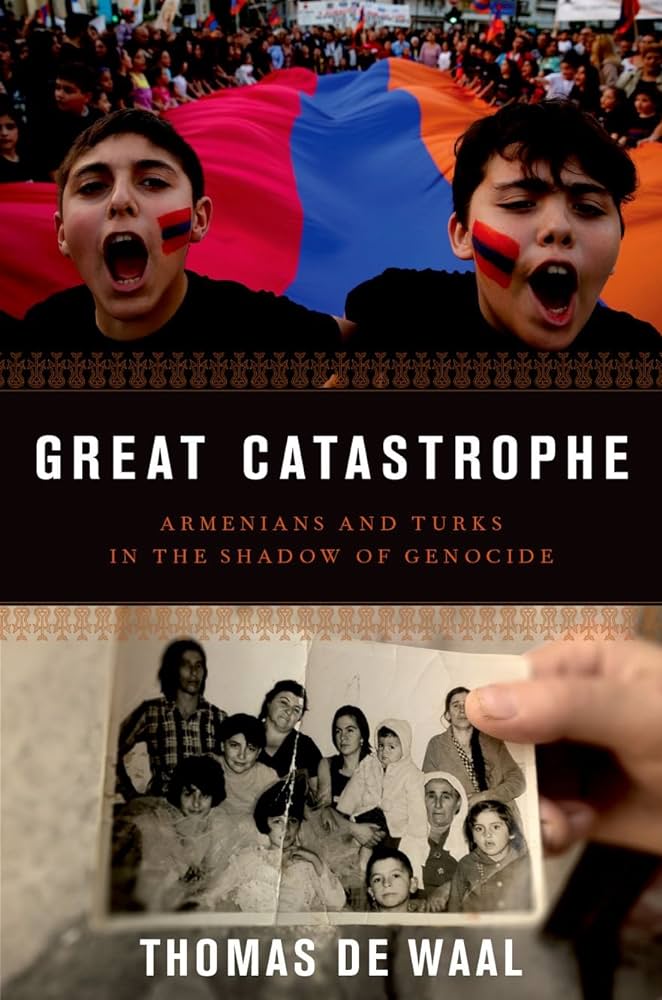|
The Great Catastrophe
By Thomas de Waal Published in February 2015 320 Pages Thibault’s Score: 4/5 Writing about genocide is hard. People hate reading lists of atrocities followed by more atrocities. Further complicating the issue is the fact that the Armenian genocide was two sided. Although more Armenians than Turks were slaughtered; the killing went both ways. Although few people want to study genocide, doing so is a moral imperative - failure to do so is bound to result in more atrocities. Considering the challenges that surround writing about such a contentious topic, Thomas de Waal did a phenomenal job. In 1915, the Ottoman Empire was dragged into World War One. The backwards, outdated Ottoman military stood little chance against the superpowers of Russia and Britain. Worse, the Ottomans had just recently come out of three decades of nonstop war which resulted in the secession of most of the Christian Balkan states and loss of North Africa. The war-weary and tired Ottoman population came to resent the Armenians for many reasons. First, the Armenians were a highly educated and intellectual minority group. Armenians occupied many high level government positions, and many of the wealthiest people in the empire were Armenian. Second, Armenians held strong cultural ties with Europe. Armenians did not dress in traditional Turkish garbs, and instead wore the clothing of Europeans. Finally, many Armenians resented the Turks after centuries of oppression, and had strong sympathies with Russia and Britain. Many Armenians went as far as going into open rebellion against the Ottomans, and massacred small groups of Muslims in contested areas. It is important to note that only a small handful of Armenians rebelled against the Ottoman Empire. The Turkish solution was to eliminate all non-Turkish populations. Several groups of Christians - namely Armenians, Assyrians, and Pontic Greeks - were marked for extermination. What followed would be the wholesale destruction of 1.5 million Christian civilians. Many reprisal killings against Turks would later follow, with some resulting in massacres and rape of tens of thousands of Turkish civilians. The Armenian genocide itself only accounts for one third of the book. The following two thirds follow the history of the Armenian diaspora in the United States and Europe, and of the Soviet Armenian state. The book ends with a short account of the wars in between Armenia and Azerbaijan. I found the latter half of the book, which explains what happened to the Armenians after the genocide, to be the most fascinating part of the story. First, what shocked me / terrified me is that many Armenians attempted to deny that the genocide had occurred. Many of the direct victims of the killings were traumatized, and preferred to forget the events of 1915 rather than speak about them. Women who were captured and taken as sex slaves or forced brides adopted new Turkish identities and did their best to forget that they were Armenian. Other Armenians were themselves implicated in war crimes or revenge killings, and also chose to forget. Early Armenian attempts at erasing the genocide would later on be used by Turkish nationalists to perpetuate the idea that the genocide had never occurred. Second, the book explains how the term “genocide” came to be applied to what we today call the Armenian genocide. In 1915, the word “genocide” did not yet exist. Instead, people at the time referred to it as “the Great Catastrophe.” The word “genocide” was coined during World War Two by a Polish social scientist Raphael Lemkin commenting on the Holocaust. Lemkin specifically cited several past events which he believed to be genocides in his initial writings about the topic, such as the invasion of Ghenghis Khan, and importantly, the Armenian genocide. Some Armenians began immediately using the word “genocide” after Lemkin created the term. Finally, the coverage of the conflict between the pro-communist and anti-communist Armenian groups was fascinating. Some Armenians saw Russia as the liberator which protected the Armenians against Turkey; others saw it as a second oppressor and the perpetrator of a second genocide. In many ways, this conflict still exists today. The nation of Armenia finds itself uncomfortably wedged in-between two major enemies - Turkey and Azerbaijan. Many believe that, without Russia, Armenia would have already been overrun. I highly recommend this book for anyone who wants to study Armenian history as a starting point.
0 Comments
Leave a Reply. |
Thibault SerletMost of my articles are book reviews, but I also write about many other topics. Archives
December 2023
Categories |

 RSS Feed
RSS Feed